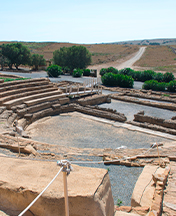According to ancient Greek mythology, Lemnos was the island of Hephaestus. Legend has it that he landed on this island when Hera, his mother, threw him off Olympus because she saw he was ugly. The inhabitants of the island took care of him and in return, he taught them the art of blacksmith. However, another myth connects the history of Lemnos with Philoctetes, an ancient hero who was abandoned in Lemnos on the road to Troy. The archaeological excavations in the temple of Kaveiri and the ancient site Poliochni brought to light early settlements from the Bronze Age. Lemnos came under Persian rule in the 5th century BC and joined the Athenian Alliance after the end of the Persian Wars, it rempart of which it remained for almost the entire Classical Period. Then Lemnos passed into Macedonian rule. The Romans declared the island free in 197 BC but gave it back to Athens in 166 BC. After the division of the Roman Empire, Lemnos joined the Byzantine Empire. After the fall of the Byzantine Empire, Lemnos became the prey of pirate raids. In 1453 it came under Genoese rule, which brought great economic and commercial prosperity. From 1462 to 1479, Lemnos was the subject of wars between the Venetians and the Turks. Venice was forced to give it to the Ottoman Empire when it became the supreme power of the Aegean. After the Greek Revolution of 1821, Lemnos, like the other islands of the Eastern Aegean, did not join the newly built Greek State. Lemnos was finally liberated in 1912 but incorporated into the rest of Greece in 1920.












